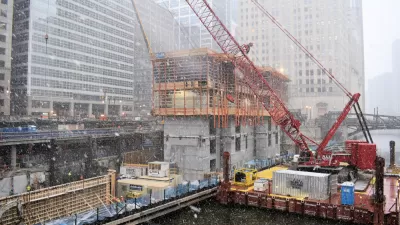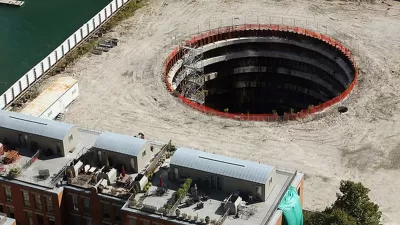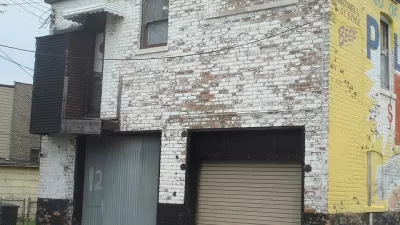Developers Related Midwest have new plans for the infamously failed development site, but have so far been stymied by demands from the office of Alderman Brendan Reilly.

Blair Kamin does not mince words in when describing the causes of a recent decision by an alderman in Chicago regarding the long-languishing former planned location of the Chicago Spire:
In rejecting developer Related Midwest’s proposal for the former Chicago Spire site at 400 N. Lake Shore Drive, Ald. Brendan Reilly, 42nd, is kowtowing to the NIMBY instincts of his constituents, who clearly don’t want the world streaming through their high-rent backyard.
The impact of the decision spreads to the Cityfront Center, which Kamin recently documented in a feature-length interactive story that serves as a cautionary tale about mega-project planning.
In the case of the former Spire site, the project would have further the incomplete goals of the city's master plan for the Cityfront Center to leverage private development for the benefit of public open space. "The developers even pledged $10 million to help build the long-stalled DuSable Park," according to Kamin.
In fact, reports Kamin, the concerns of the constituents, as represented by the actions of Alderman Reilly seem to be in making the public space around the building less open. According to Kamin, "in an email to constituents Monday, Reilly announced that the plan “remains stalled” and will stay that way until Related Midwest responds to a list of concerns from neighbors, including this absurd pair: Get rid of the proposed public esplanade along the Ogden Slip and develop a “security plan” for the Riverwalk and DuSable Park."
FULL STORY: So much for those smart plans for the Chicago Spire site. They're falling victim to Reilly's NIMBY cave-in.

Study: Maui’s Plan to Convert Vacation Rentals to Long-Term Housing Could Cause Nearly $1 Billion Economic Loss
The plan would reduce visitor accommodation by 25,% resulting in 1,900 jobs lost.

Placekeeping: Setting a New Precedent for City Planners
How a preservation-based approach to redevelopment and urban design can prevent displacement and honor legacy communities.

Using Old Oil and Gas Wells for Green Energy Storage
Penn State researchers have found that repurposing abandoned oil and gas wells for geothermal-assisted compressed-air energy storage can boost efficiency, reduce environmental risks, and support clean energy and job transitions.

Washington State Plans Ambitious ‘Cycle Highway’ Network
The state is directing funding to close gaps in its existing bike network and make long-distance trips more accessible.

Homeowners Blame PG&E for Delays in ADU Permits
The utility says it has dramatically reduced its backlog, but applicants say they still face months-long delays for approvals for new electrical work.

Rethinking Wildfire Defense: How a Landscape Approach Can Protect Neighborhoods
Post-fire analysis of the Eaton Fire reveals that a landscape approach — including fire-resistant vegetation, home hardening, and strategic planning — can help reduce wildfire risk, challenging assumptions that trees and plants are primary fire hazards.
Urban Design for Planners 1: Software Tools
This six-course series explores essential urban design concepts using open source software and equips planners with the tools they need to participate fully in the urban design process.
Planning for Universal Design
Learn the tools for implementing Universal Design in planning regulations.
Borough of Carlisle
Caltrans
Heyer Gruel & Associates PA
Institute for Housing and Urban Development Studies (IHS)
City of Grandview
Harvard GSD Executive Education
Salt Lake City
NYU Wagner Graduate School of Public Service
City of Cambridge, Maryland





























